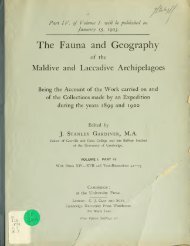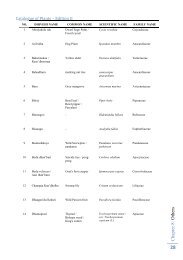Download - WordPress – www.wordpress.com
Download - WordPress – www.wordpress.com
Download - WordPress – www.wordpress.com
You also want an ePaper? Increase the reach of your titles
YUMPU automatically turns print PDFs into web optimized ePapers that Google loves.
640 R. C. PUNNETT.deeply sunk position which it exhibited in the branchial region. Subgenital pits such asWilley found in Spengelia ('99, p. 274) are absent. The gonads form a single row oneither side of the body. Ripe spermatozoa occurred in the specimen from which the sketchof the genital region was taken.As belonging to the family Glandicipitidae there have already been described threegenera, viz. Schizocardiuni, Glandiceps, and Spengelia. It cannot be said with any confidencethat Willeyia bears a closer resemblance to any one of these genera than to another.Features which separate it from all these three are the shortness of the nuchal cornua,the <strong>com</strong>paratively small extent of the branchial portion of the oesophagus as <strong>com</strong>pared withthe digestive, and possibly also the absence of gonads in the branchial region. With respectto other features of generic importance Willeyia resembles now one genus and now another.To which of the above genera it bears most resemblance with respect to the more salientfeatures of its anatomy may be gathered from the appended table, p. 639.Balanoglossus carnosus, Willey, 1899 (PI. XXXVII. fig. 3).Locality, etc. The greater portion of a very large specimen was obtained at Minikoi,at the base of a cyluidrical casting in the sand flat lagoon. Fragments of the same specieswere also found at Hulule in sand under a large Porites mass close to the boulder zone.A coloured sketch was made of the Minikoi specimen by Mr Forster Cooper beforepreservation. This is reproduced on PI. XXXVII. fig. 3, and shews the natural colours ofthe animal. A bright yellow line occurred mid-ventrally which was probably the nerve cord.The dimensions of this large specimen were taken by Mr Gardiner while it was yetalive. I have also taken them on the preserved specimen and the results of both are asfollows : Living PreservedLength of proboscis beyond collar... 9 mm. 3 mm.Breadth „ 5 „ —Length of collar 22 „ 13 „„ „ branchial region — 60 „„ „ genital pleurae — 204 „„ „ animal obtained 440 „ 35.^ „When alive and undamaged the animal probably exceeded 60 cm. in length, and possessedan average diameter of 10—12 mm. The above measurements agree fairly well with thosegiven by Willey ('99, p. 248). There appears to be considerable vai-iation in the relativelength of the branchial region which may be somewhat less than double the collar length,or may be as much as four times as much. The present specimen agrees with the largestof Willey 's specimens, which it rivals in size, in having a relatively long branchial region.In addition to the above fairly <strong>com</strong>plete specimen a number of jelly tubes were foundat the surface in castings similar to that which marked the position of the large worm.These tubes were much distended with sand, and of a transparent straw colour with bi-ightyellow mid-dorsal and mid-ventral lines. The edge of the free (= anal ?) end was markedby brown-black jaigment. Doubtless these tubes are the broken off caudal ends of thisspecies. Like Pt. flava (see p. 646) it may have developed the habit of autotomy.Balanoglossus parvulus, n. sp. (PI. XXXVIIL figs. 15, 18, 22; PI. XXXIX. fig. 24;PI. XLI. figs. 1—4).Locality, etc.Represented only by a fragment <strong>com</strong>prising the anterior end and includingthe proboscis, collar, branchial region, and a portion of the genital region. From Mahlos Atoll.






